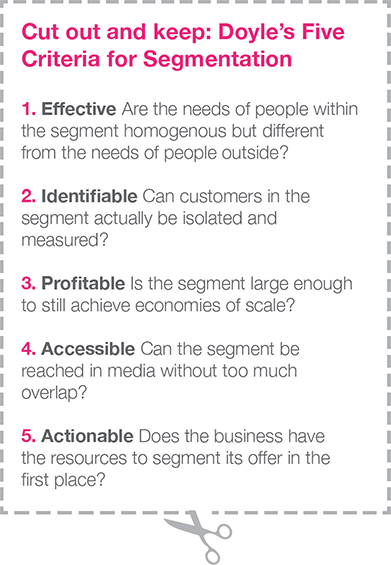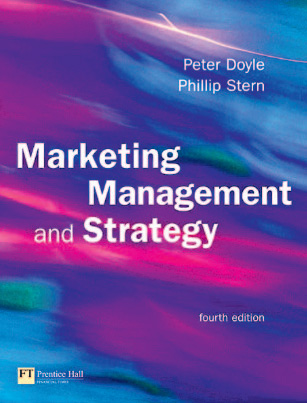Sense and segmentation
If you’re reading this column online, what you won’t see is that the version in print features a cut-out-and-keep panel, a segment that contains, appropriately enough, the 73 sanest words you’ll ever hear on the subject of segmentation. (The online crowd just gets a link.)
 The words aren’t mine. They are those of the late Professor Peter Doyle – his famous ‘five criteria’ – and they should be kept handily about the person in the event of ambush by an enthusiastic promoter of a segmentation strategy that, allegedly, will be transformative for your brand.
The words aren’t mine. They are those of the late Professor Peter Doyle – his famous ‘five criteria’ – and they should be kept handily about the person in the event of ambush by an enthusiastic promoter of a segmentation strategy that, allegedly, will be transformative for your brand.
Leaps into segmentation silliness can come from anywhere, but the chief culprits are researchers and agency planners. They are dangerous in the usual way – they build on something solid, so your guard is down, they add a top-note of pure imagination, so your spirits soar, all of which blinds you to the fact they’ve left a great big hole in the middle, where crucial data should be.
What’s solid enough is the notion of segmentation itself, as a viable marketing strategy. Without it, markets, consumers and brands would all be the poorer, in categories from airlines to dog food. So it’s easy to nod in anticipation to one that might apply to you.
Doyle’s ascension through the scholarly ranks was alarmingly quick: before the age of 30 he had lectured at London Business School, Stanford and INSEAD and was appointed chair of marketing at Bradford University.
After being made professor of marketing at Warwick, he scooped a ‘Best Paper’ award from the Academy of Marketing, and a Gold Medal from the AMA.
Doyle was a brilliant teacher: funny and a little frightening, with a fine grasp of ‘the numbers’. Students were famously reluctant to leave the room at the end of his lectures.
His classic 1994 textbook, Marketing Management and Strategy, is probably the most widely used marketing text on European MBA programmes.

Classic Peter Doyle’s work is widely used
Pictures will be shown, life stories painted, and – the telltale sign of danger – the segment will be given a natty name: ‘mildly messy moms’, ‘home haven hunters’, ‘disorganised divas’.
The missing piece? Everything that really matters: How many? How profitable? With what overlap? Can they be economically reached? Do not worry. Doyle’s criteria will help you fill that void – as they have more than once for me.
Doyle’s criterion No.4, alone, would put a line through most of these wild segmentation forays: how do you isolate your discrete target in communications? I remember an agency pitch for a muesli brand where the planner had separated the female universe into ‘Mrs Harvest’, who likes to put a lot of variety on the table, and ‘Mrs Plain’, who plays it straight, culinary-wise.
Aside from the absurdity of naming rounded human beings as though they existed only in the breakfast dimension, and rendering them immutable, as though they couldn’t be one thing on a Wednesday and another at the weekend, the strategy was daft because there was no way of isolating the desired ‘Mrs Harvest’ in media. Turned out she read and watched the same stuff as dull old Mrs P.
Segmentation can be professionally satisfying and financially rewarding, but it is dangerous without Doyle. There will, unfortunately, always be people out there who do not know or accept that. We cannot change them, we probably cannot educate them, but, hey, we can give them a name: Segmentals.
